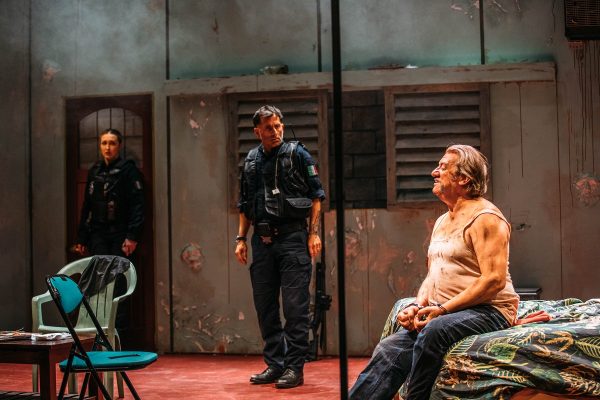
Theatre / “Twenty Minutes with the Devil”, world premiere. At The Street Theatre, June 18. Reviewed by JOE WOODWARD.

Theatre / “Twenty Minutes with the Devil”, world premiere. At The Street Theatre, June 18. Reviewed by JOE WOODWARD.
WHAT can be made out of a shabby motel room in the middle of nowhere with three people, albeit with two lowly police patrol officers and the world’s most wanted man?
The Street Theatre’s production of “Twenty Minutes with the Devil” provides an astonishing answer due to the crafting of a text by Luis Gomez Romero and Desmond Manderson and a superb creative team of Caroline Stacey (director), Imogen Keen (production design), James Tighe (sound design), Antony Hateley (lighting design) and Zsuzsi Soboslay (movement).
The three actors, PJ Williams, Joanna Richards and Raoul Craemer compounded the piece with three very different energies that combined to create tensions that compelled the action into its ultimate denouement. The production achieved that rare ability to weave divergent themes into a single moment of staged value.
The contradiction of a cocaine-using establishment enacting the so-called war on drugs and ironically creating the very beast it aims to destroy is clearly articulated by Williams’s character of El Ticho. His world is absurd, necessary and stark. He is no stranger to shit. There is no room for sentiment. In this small room he challenges the extreme repression and subjugation of the underlings who supposedly arrested him and keep him in confinement while the real powers arrange the outcome.

This might sound like a dry argument. Dialectics for the philosophy department! However, the very different energies of the characters provide a powerful theatricality that is constantly heightened through use of a subtly tuned technology that is often the prerogative of musicals. The fine tuning of special production effects, lighting and sound imagery provides opportunities to remove the circumstances from a banal room into a wider universe of social and cultural experience.
Themes compete for our attention. They are given platforms for consideration. And possibly for rejection! It is rare for a production to move so far from a narcissistic focus of individual existential dilemma and into a complex matrix of wide-reaching gravity that draws in networks of power and daily lives well beyond the confines of a particular event.
It was initially alienating to watch seemingly pantomime acting styles within the apparent realism of the situation. The comic and the absurd were countered with severe direct addresses to the audience. Such strange juxtapositions of style were to make more sense as the play progressed. The political and the comedic compelled attention in ways that might be confusing to some people who have very fixed views on the world and their own place within it. Yet this confusion is precisely what the work reveals as its premises.
Some might argue that certain points raised by the characters were clichés that “everybody knows”. While there might be some justification for this view, within the context of the work, cliché knowledge held by the protagonists was used to evoke their world views and be open to challenge.
Characters exposed their weaknesses and ability to change in surprising ways. Within the wider circumstances their microcosms provided the human connection with each other and ultimately with the audience. While these changes were not always obviously justified, they moved the piece forward and reminded the audience that ultimately, this is just a play…
In a world of spin and confusion, there’s never been a more important time to support independent journalism in Canberra.
If you trust our work online and want to enforce the power of independent voices, I invite you to make a small contribution.
Every dollar of support is invested back into our journalism to help keep citynews.com.au strong and free.
Thank you,
Ian Meikle, editor
COLIN STEELE reviews a couple of biographies from British comedians Michael Palin and Bill Bailey.
"Sarah Ruhl’s acclaimed play accomplishes much in just about an hour. Its brevity demands an economy of expression that conveys immense emotional depth." ARNE SJOSTEDT reviews Eurydice, at the Mill Theatre.
The performance year may be starting to slow, but HELEN MUSA's still got an Artsweek column full of entertaining events.
Sponsored Content
Leave a Reply